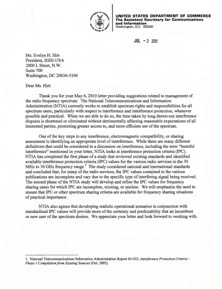FCC and NTIA Leadership BOTH Send Evasive Letters on Key Spectrum Issues
On July 2, Asst. Sec. Strickling replied to IEEE-USA’s May 6 letter urging FCC and NTIA to work together to clarify what is “harmful interference” since this phrase is used repeatedly in the Communications Act and the only formal definition is one recycled for the ITU that is murky in many practical situations. (FCC has not yet responded to this letter.) In practice, drawn out harmful interference determinations by both NTIA and FCC have significantly delayed access to spectrum for new technologies.
Asst. Sec. Strickling seems to agree with the basic premise of the IEEE-USA letter, saying
“NTIA currently works to establish spectrum rights and responsibilities for all spectrum users, particularly with respect to interference and interference protection, whenever, possible and practical. When we are able to do so, the time taken by long drawn-out interference disputes is shortened or eliminated without detrimentally affecting reasonable expectations of all interested parties, promoting greater access to, and more efficient use of spectrum.
But the letter then goes on to reference an NTIA report that is almost 5 years old: Interference Protection Criteria: Phase 1 - Compilation from Existing Sources, NTIA 05-432, Oct 2005 . This report is a good background study reporting mostly on ITU-R recommendations relating to well known systems. The ITU-R recommendations are not generally binding on FCC and NTIA in the usual case of a domestic system sharing with another domestic system, although they are important in the case of satellite systems and systems near the US and Canadian borders.
The report was supposed to be part of the 2 phase study. Five years ago, the report stated:
In the second phase of this study, NTIA will review the relevant federal government policies and practices regarding IPC and recommend regulatory and technical refinements that may improve IPC application’s scope, utility, clarity, or effectiveness.
That is really the question at hand. Asst. Sec. Strickling,
- Does NTIA have schedule for doing this?
- Will NTIA involve the public in this issue?
- Will it work jointly with FCC on this issue?
On May 28, Senators Rockefeller and Kerry sent Chmn. Genachowski a joint letter:
We are writing to urge you to immediately begin a comprehensive inventory of the use o f radio spectrum by non-federal government licensees and users under the Federal Communications Commission's jurisdiction.
Radio spectrum is a scarce, but valuable resource. As more and more of our communications take place using wireless technology, it is vitally important for us to understand how spectrum is allocated and used. Indeed, gaining a better understanding of how we use spectrum is the first step toward identifying how we can use this resource most efficiently to carry out critical government missions and to help bring more advanced communications services to consumers across the country.

“the general public with access to information about various spectrum bands, including usage and licensee information, mapping and analysis tools, and the ability to browse and download data.”
Chmn. Genachowski,
- Will the “usage” information include information based on any actual observations or just the reformatting of data presently in FCC databases?
- Since cellular carriers do not now report cell site location and coverage data, how will you present CMRS information?
- Current broadcast contours used for Part 73 licensing and used for protection of broadcast spectrum in some contexts are based upon Part 73 propagation models that assure “administrative certainty” for broadcasters but do not realistically portray their actual coverage, will broadcast spectrum use be presented based on these traditional models or based on contemporary readily available propagation models?





![Validate my RSS feed [Valid RSS]](valid-rss-rogers.png)

